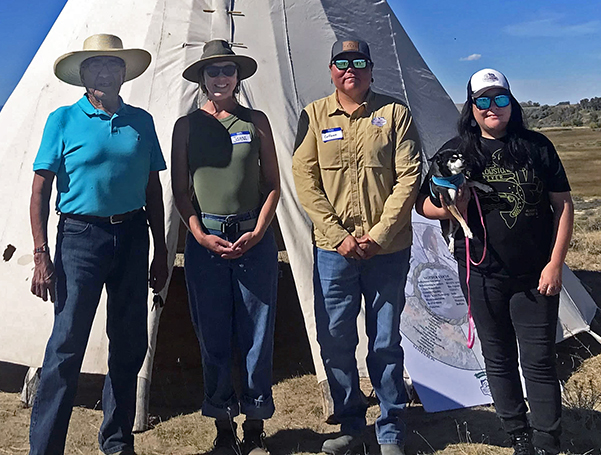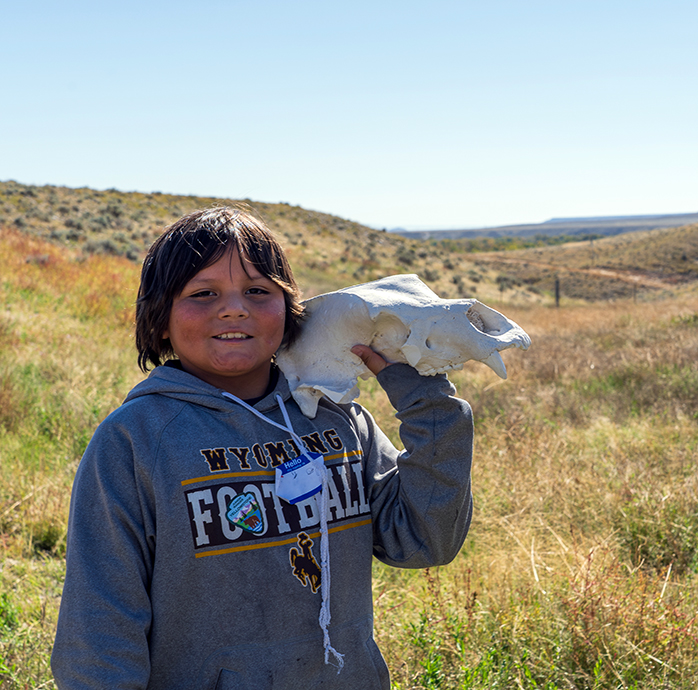“When the Elder prayed, the buffalo appeared to listen in”
Published May 03, 2024
Janna Black organizes Indigenous youth camp as thesis project
In September 2023, the Indigenous Youth Culture and Climate Day camps started with a memorable moment: An elder was saying a prayer in Shoshone. She paused, looked up and said a buffalo had joined to listen and recognized the Shoshone language. Indeed, a buffalo was perched up on the hillside. When the prayer was finished the buffalo came down toward the camp and to the river. The 41 fifth graders from Wyoming Indian Elementary School, who had assembled for a day at the Shoshone Buffalo herd within the Wind River Indian Reservation, were impressed and couldn’t stop talking about it. Hearing this story from camp organizer Janna Black during her thesis defense is enough to give anyone goosebumps.
More Than One Way of Knowing
As part of her Master of Science in Environment, Natural Resources & Society degree on the Plan B track, Black planned and organized three-day camps at the Shoshone buffalo herd pasture for grades 5, 8 and 11-12, respectively. Plan B studies replace a traditional thesis with a more flexible project.
Black, who spent several years as an organic farmer and homeschooling mother in Washington state before she came to University of Wyoming in 2022, says her perspective is shaped by a holistic view of ecology where everything is interconnected. She seeks to combine, or as she expresses it, “braid together,” Indigenous, local, and scientific knowledge systems to generate new insights and innovations.
This approach of knowledge co-production is also at the heart of UWyo’s WyACT five-year project on the effects of the changing climate on Wyoming’s waters. Black’s graduate advisor Corinne Knapp, professor at the Haub School of ENR, is also a co-PI of WyACT. She feels that projects like this complement climate-change research seamlessly: “The Wind River that gave today’s Eastern Shoshone and Northern Arapaho reservation its name, is one of the headwaters rivers of the project, and the Tribes of Wyoming will feel the effect of environmental changes intensely due to their close connection with the land.”

The core planning team for the Indigenous Youth Camps (from left): Wes Martel, Janna Black, Colleen Friday, and Signa McAdams
Janna Black wanted to help strengthen sense of place rooted in culture through intergenerational land-based learning. Wes Martel, Senior Wind River Conservation Associate with the Greater Yellowstone Coalition, was a key member of her planning team. He agrees: “I always talk about strengthening our families and our communities, and this camp was a good start for that.”
Partnerships played a crucial role in the success of the Indigenous Youth Culture and Climate Day camps, and the collaboration with the Greater Yellowstone Coalition was particularly impactful. Their commitment to conservation and cultural education aligned perfectly with the camp's mission, creating a strong foundation for meaningful, land-based learning. The Coalition's involvement not only provided essential resources but also helped foster a deeper connection between the students and their environment. Their support enabled the camp to go beyond traditional education, allowing youth to engage with their heritage while understanding the broader environmental challenges facing their lands. This partnership highlighted the power of working together to create lasting, positive change for both communities and the environment.
A day in the outside classroom
So, how did the day camp go about achieving this? Near Kinnear, where the buffalo heard roams, a teepee and nine booths were set up. Student groups took turns attending the stations for 20-minute hands-on “lessons”. They learned new Arapaho and Shoshone words, got to see and touch many cultural objects, furs and bones, and learned Arapaho hand games. Plants like the landscape-defining sagebrush played a large role in the lessons, as did animals, first and foremost the buffalo, whose many uses and cultural significance was stressed at several stations. At the camp itself, the buffalo provided nourishment: In the form of buffalo burgers that the students helped prepare!

Youth camp participants were able to interact with a variety of animal furs, bones, and skulls
Not all activities were stationary – students walked around the landscape identifying plants and climbed a vantage point to spot signs of drought across the river. Immersed in the beauty and sacredness of the land, the next generation of leaders got some impulses to think about their future.
There were only four months to plan the camps with a core team of four people. Black cooperated with the High Plains American Indian Research Institute (HPAIRI) at UWyo, which is working out a process for the University and the Northern Arapaho and Eastern Shoshone people to work together. Having a process is helpful, but: “Building relationships is very important” stresses Black. “It is important to have reciprocal relationships based on trust, sense of belonging, and accountability”.
Building relationships and trust takes time and effort. But the results were well worth it. Students expressed increased knowledge about the land and their culture and came up with many actions to conserve water and protect the environment.
Blueprint for Land-Based Learning
The success of the camp can also be measured by the fact that the second edition is slated for June. And the concept does not have to be confined to the Wind River Indian Reservation. Black: “While there were many elements specific to the location, the planning process could be a blueprint for other Tribes and regions.” She describes the steps for planning and holding the camp in great detail in an illustrated brochure available as PDF and a limited number of printed copies.
Now that she has graduated, what is next for Janna Black? “I am the new Tribal Climate Resilience Liaison working for the Great Plains Tribal Water Alliance and closely with the North Central Climate Adaptation Science Center. She will be Working to connect resources to Tribal Nations in climate adaptation efforts in the north central region which consists of 32 federally recognized Tribes from Montana, Wyoming, Colorado, North Dakota, South Dakota, Nebraska, and Kansas. “I am looking forward to helping Tribal Nations build climate resiliency and sustainability for many years to come.”
Camps were funded through a Western Water Assessment (a NOAA-funded CAP RISA) small grants opportunity and Janna's time was funded through a Kemmerer Fellowship and the WyACT Project.

